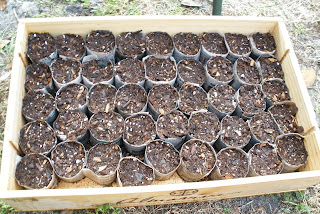I recently discovered an apiary near my home (Biggers Apiaries). I purchased a gallon of Orannge Blossom honey with the vague notion of making mead with it. I attended a class on making medicinal meads at the Organic Growers School Annual Conference this year, so I pulled out my notes for review and watched a couple of mead-making videos on YouTube. (Allow me to recommend the videos of "Craigtube" and "EpicFantasy".) It looked almost too easy. I couldn't wait to get started.
Since I've made my own beer and ciders, I had all of the equipment that I needed. I was going to make gallon batches, so I needed gallon carboys, stoppers, airlocks, a large stock pot, 4 cup measuring container, cooking thermometer, and a funnel. I filled the kitchen sink with hot water and Star-San sanitizing solution. I sanitised all of the equipment while 6 quarts of water heated in the stock pot on the stove. (Bleach can be used to sanitize the equipment, but be sure to rinse everything VERY well.)
The basic formula for mead is 3 parts water and one part honey + (wine) yeast. I decided to make 2 gallons of regular mead, and 2 gallons of berry melomel (fruit meads are called melomels). So I heated 6 quarts of water and 2 quarts of local orange blossom honey in the stock pot. Heat the water and honey to 150 degrees Fahrenheit for 30 minutes, stirring periodically. This will pasteurize the honey. After 30 minutes I poured the must (the water and honey before fermentation) into two carboys. The must is too hot to pitch the yeast at this point, so I kept the bottles in a cold water bath in the sink to bring down the temperature. I also took a potential alcohol measurement with a hydrometer. The reading came to 13%. So if all goes well during fermentation, the mead should have an abv of 13%.
While I waited for the must to cool, it was time to make the second batch. Again, I heated 6 quarts of water and 2 quarts of honey to 150 degrees Fahrenheit. After the must had been at 150 degrees for 15 minutes, I added one cup of dried, organic elderberries and two cups of previously frozen blueberries. As the must cooked for another 15 minutes, the whole kitchen started to smell like blueberry cobbler.
As with the mead, I funnelled the melomel must into two 1 gallon carboys and set the carboys in a cold water bath to cool. The cooling process took a long time, and next time I believe I will only cook half the water with the honey and add the other half as cold, bottled, spring water to cool the must immediately. I took a hydrometer reading of the melomel must, and got a potential alcohol reading of 12%.
Once the musts were cooled to less than body temperature (I waited until mine was at 80 degrees Fahrenheit) they were ready for the yeast. I used Red Star Pasteur Champagne yeast. One package of this yeast is good for 5 gallons, so I mixed the yeast with one cup of warm water, and poured 1/4 a cup of the yeast mixture to each carboy. I also added a handful of raisins to each carboy to act as a yeast nutrient. I capped the carboys and gave them all a good shake to make sure everything was well mixed. Then I replaced the caps with drilled (#6) rubber and (homemade) cork stoppers and airlocks.
Twelve hours later, the carboys are bubbling and the airlocks are gurgling.






































